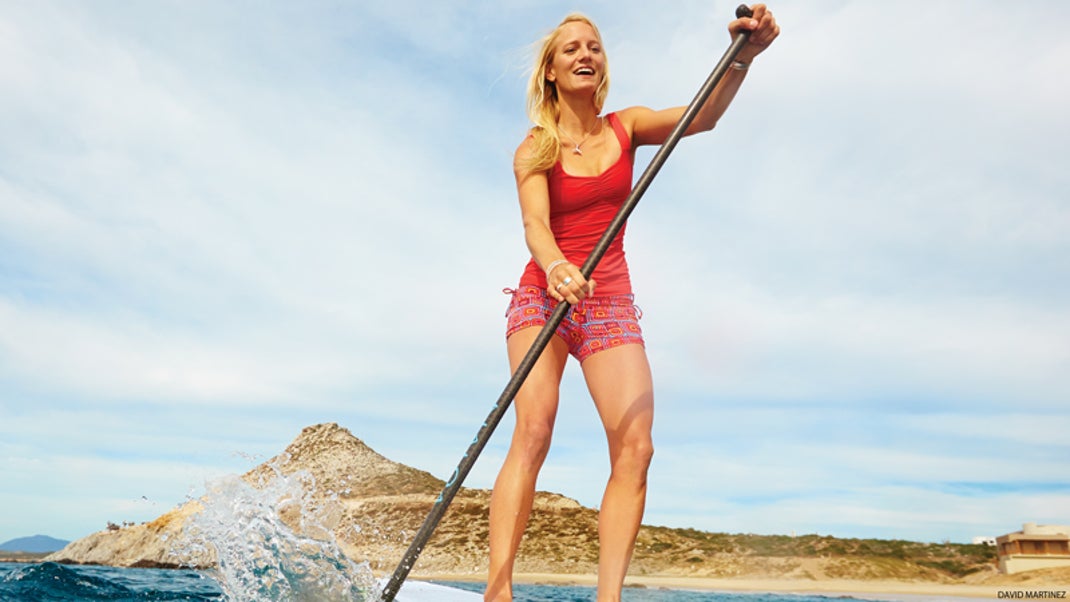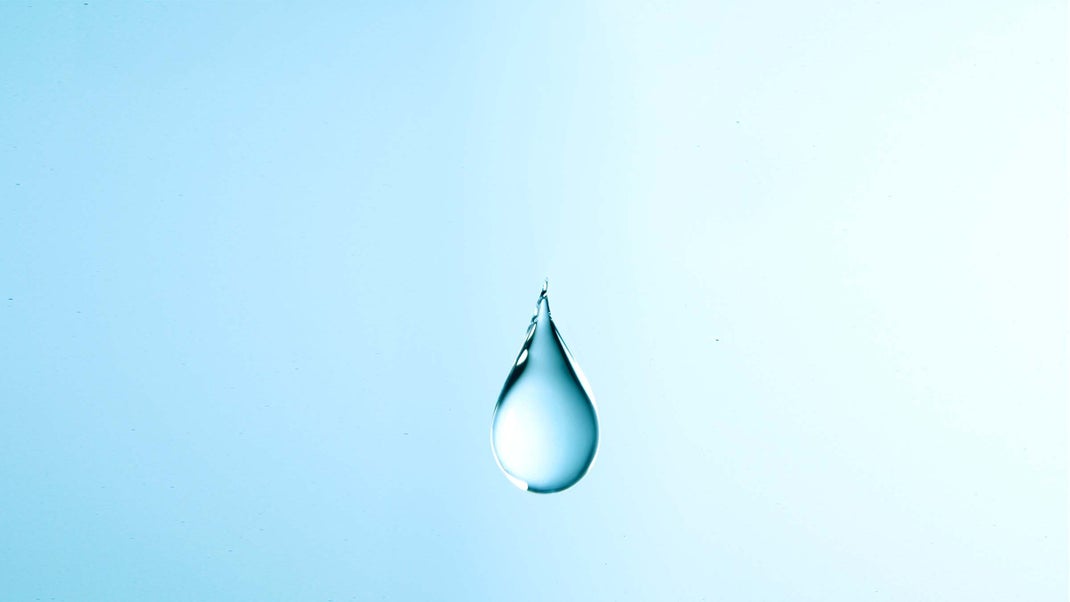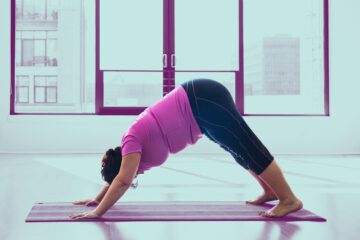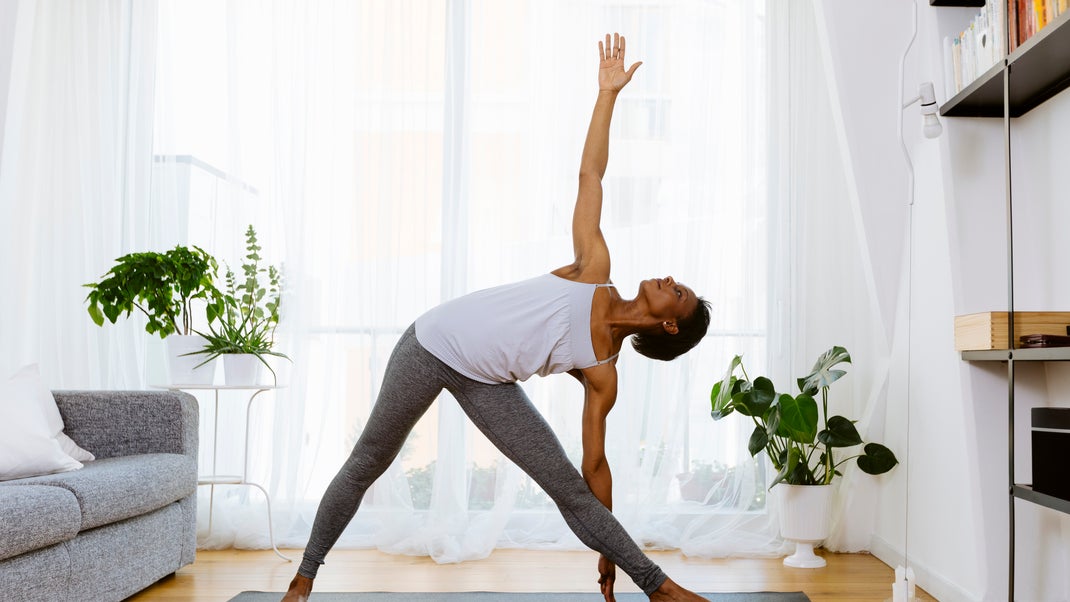It’s 4 o’clock in the morning and you’re standing on your board. The sun is rising, birds are chirping, and this might be one of the most perfect moments in your life. You take a deep breath and savor the moment before paddling back to shore for breakfast with friends.
It’s early in her morning practice when Gillian Gibree takes a familiar asana: Adho Mukha Svanasana (Downward-Facing Dog Pose). To start waking up her arms and legs, she presses evenly through her hands and feet. She lifts her sitting bones skyward as she relaxes her neck and finds an extension in her long spine.
Her wispy blond hair falls about her face, but what comes into view when she looks back between her ankles is not the wall of a yoga studio. Instead, it’s where the cool, blue ocean meets the sky in San Diego Bay. Seagulls fly in the distance, and at any moment, a dolphin may make an appearance.
Her mat? An epoxy paddleboard that gently rocks with the Pacific’s undulating waves. Gibree shifts her weight from front to back and side to side to steady her floating Down Dog.
“It’s a totally different experience than in the studio,” says Gibree, a vinyasa yoga teacher and professional standup paddleboard racer who first began playing with yoga poses on her board in 2009. “You’re out in the elements and have a total connection to nature. It’s so relaxing and meditative. It feels amazing.”
The beginner-friendly sport of standup paddleboarding was born in the 1940s when Waikiki surfers stood on boards and navigated their way through the waves with a long paddle. Standup paddleboard yoga (or SUP yoga, as it’s known to its devotees) is asana practiced on 10- to 12-foot-long boards in the most serene of settings: an ocean bay, a glassy lake, even a slow-moving river. In recent years, water-loving yogis—some with board sport experience, like Gibree, some without—have embraced SUP yoga as a practice that brings a sense of joyful freedom to an otherwise earth-bound yoga practice.
“On the water, I have to let go of any control or wanting to do everything perfectly because, at any moment, the current can change everything, and I’ll be in the water,” says Jessica Taylor, a vinyasa teacher who started her SUP yoga practice in Savanna, Georgia, where many mornings she’d warm up by paddling against the current on Richardson Creek near her home. Over the spring, she moved to Jacksonville, Florida, where she now practices at Neptune Beach. “In a studio, I find myself trying so hard to do everything perfectly that I forget how fun yoga is. SUP yoga is a reminder that it’s not so serious.”
Taylor begins her playful practice with a few grounding asanas like Cat-Cow Pose and Balasana (Child’s Pose) to get her balance. Then she moves on to more challenging standing poses such as Vrksasana (Tree Pose) and Virabhadrasana I (Warrior Pose I), which can end in the water if her weight isn’t evenly distributed front to back or side to side.
She compensates by using a wider stance and rocking with the waves—and by letting go. “The worst that can happen is that I fall in and get back up,” says Taylor, who notes that not taking yourself too seriously is crucial to making it fun. In that spirit, she and her SUP yoga students give each other snaps when someone goes over.
Rock and Roll
In New England, where Karen Fraser teaches SUP yoga, the rougher Atlantic waters can turn practice into a thrill ride. “The craziest day out was when the waves were chest high,” says Fraser. “I took a group of fellow instructors out, and just doing Downward-Facing Dog was challenging. It was like riding a bucking bull. We had a lot of laughs.”
It’s a fun practice but with some serious benefits. Doing yoga on a surface that is constantly in motion fires up your core muscles, says Gibree, and strengthens muscles that aren’t called on in everyday practice. “Even Plank Pose is more challenging because your board is moving a little back and forth, and that added tipsiness activates your core and arms,” says Gibree. “You definitely feel these tiny muscles that don’t activate on the ground.”
The challenge is part of the attraction, and it isn’t just physical, Gibree says. SUP yoga requires a different quality of focus—and not just when you’re doing the poses but also when you’re transitioning between them. For example, bringing your right foot between your hands from Downward-Facing Dog to come into Anjaneyasana (Low Lunge) can sometimes shift aboard a few inches forward—even on the calmest water. The key, says Gibree, is to make micromovements, adjust alignment and weight distribution as needed, and fix your gaze on a point along the horizon, on the shore, or even on an outlying rock or tree.
Your alignment may be different than on dry land (for greater balance, Taylor turns her standing foot out in Tree Pose, for example), but that’s OK. It’s also fine (and even fun!) if you lose balance altogether and fall overboard, says Katie Fitzgerald, a Bikram Yoga teacher who leads vinyasa classes on a lake marina in the resort town of Coeur d’Alene, Idaho.
“Falling is just part of the experience,” she says, and there’s freedom in fully embracing that. “You let go of your expectations and judgment, which is what yoga is all about in the first place: getting out of the mind and into the heart center. When I’m teaching, I love seeing the joy on students’ faces when they fall in and get right back up into a pose. That’s what we are all doing in life. We fall, whether it’s physically, mentally, or emotionally, and we get back up and try again.”
At the end of Gibree’s SUP yoga practice, she takes Savasana (Corpse Pose) on the board, where she says the perpetual motion translates to a sense of ease. “I lie there, the ocean gently rocking me, my hands resting in the water while the sunshine warms my skin. You really can’t beat that feeling.”
Floating Practice
Ardha Matsyendrasana (Half Lord of the Fishes Pose)

When the water is calm, seated poses such as Ardha Matsyendrasana are stable. If the wind picks up and the water turns rocky, Gibree’s left hand might grab the board’s back rail to get steady.
Dhanurasana (Bow Pose)
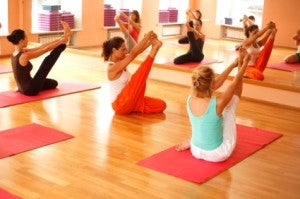
Even on land, Dhanurasana can be a balancing act. But the beautiful setting offers Gibree an even greater incentive to rise up tall with an open chest. She uses Drishti (gaze) as she naturally rocks front to back with each inhalation and exhalation.
Adho Mukha Svanasana (Downward-Facing Dog Pose)

Adho Mukha Svanasana is perhaps one of the steadiest poses to take on a SUP board. Gibree uses a slightly wider stance for more stability as she rides light waves.
Ustrasana (Camel Pose)
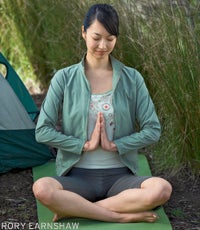
Coming into Ustrasana is all about placement—that is, keeping the hips centered and over the knees, which should land above the board’s most balanced point, the handle.
Climb Aboard!
Take your yoga off dry land at these SUP yoga classes:
Paddle Into Fitness
San Diego, California
Gillian Gibree’s Paddle Into Fitness offers classes in the bay to the public as well as SUP yoga teacher training for yoga teachers.
For more information, visit paddleintofitness.com.
Coeur d’Alene Paddle Board Company
Coeur d’Alene Lake, Idaho
On summer mornings, before the resort crowd and locals hit the beach of Coeur d’Alene Lake, Coeur d’Alene Paddle Board Company leads Hatha SUP yoga sequences when the lake is stillest. If you’re up for an adventurous ride, classes are also held during rockier afternoons and evenings.
Conclusion:
4 Yoga Poses to Try On Your SUP – Floating Practice, Ardha Matsyendrasana, Dhanurasana, Adho Mukha Svanasana, Ustrasana.
For more information on where to find SUP yoga classes near you, visit paddleintofitness.com or coeurdalenepaddleboardcompany.com! Namaste!
